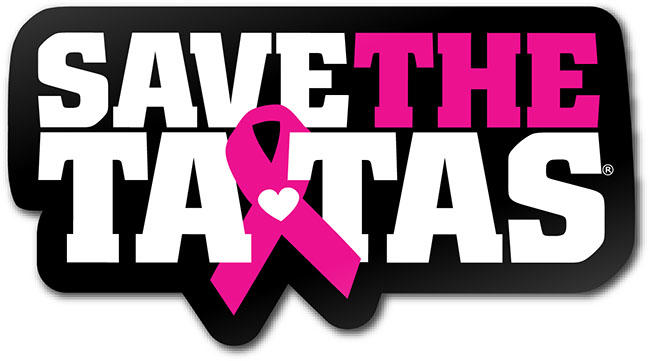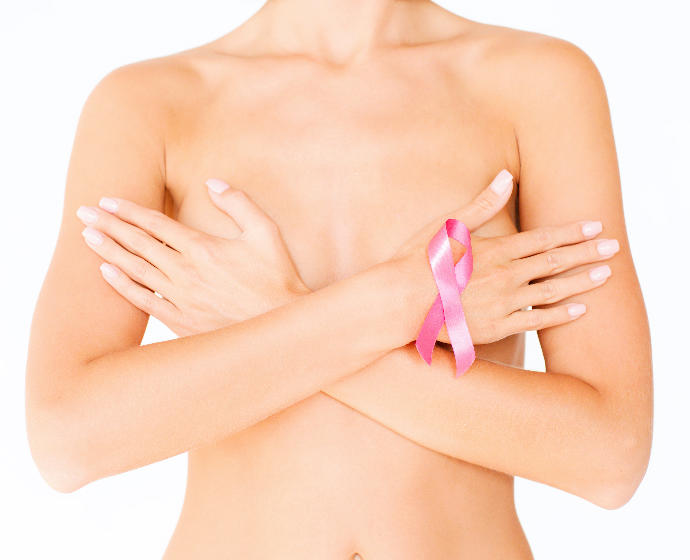
For as long as I can remember, Breast canvcer awarenss has been a big part of my life. This is because it runs very strong in my family and I can recall all to vividly my mother getting treated for it when I was only a child and my oldest sister being treated for it just last year. Watching them go through the treatments was a heart-wrenching experience and it gave me a new-found appreciation for my own life. While my mother and sister survived, some of my other relatives were not so lucky :'( So I decided to make an educational myTake about breast cancer.
What is Breast Cancer?

Simply put, breast cancer is cancer that has originated from the breast tissue. Above is a diagram of the human breast (also known as the mammary gland) which are in fact modified sweat glands. The actual breast tissue itself is composed of lobules and the lactiferous ducts. The rest of the breast is made up of fatty tissue. As you probbably already know, the primary function of the breast is to produce milk to feed a woman's child. The milk is produced in the lobules and then is trnasferred through the ducts to the nipples.
Cancer is an abnormal growth of body cells. All cells in the human body have their own specific function and some cells devide while others don't. Division of cells in the human body is carefully controlled by a series of genetic regulatory mechanisms but sometimes these mechanisms can mutate, causing the regulatory mechanism to shut down. This results in the uncontrolled division of cells which results in a tumor. Some of these cells can further spread to other parts of the body and when that happens, the tumor is said to have metastesized and be cancerous. These cells can then implant themselves in different parts of the body and grow tumors in multiple placse. This drains the body of its resources until it dies.
Who Gets Breast Cancer?

Simply put everyone can get breast cancer, but there are a number of factors that increase and individuals risk. One is obviously geneder. The average woman's risk is one in 8 while an average mans risk is 1 in 800 (but yes, it does happen to men as well). Age also increases the risk of developing breast cancer with 81% of all breast cancers occuring in women over the age of 50. Genetics can also play a role. Although 80%+ of all breast cancers occur in women with no family history. Two of the most common genes that have been identified as being responsible for breast cancer are BRCA1 and BRCA2. While an average woman has a 12.5% chance of developing breast cancer, a woman with BRCA1 has a 85% liftime risk and one with BRCA2 has a 65% chance. Also, while an average man has a .125% chance of developing breast cancer, a man with BRCA1 has a 1% risk and one with BRCA2 has a 6% lifetime risk. Also, women who have radiographically dense breasts have triple the risk they would otherwise.
How is it prevented?
There is very little one can do to 100% protectthemselves from developing breast cancer, but there are some things they can do to reduce their risk. Some of these are simple healthy lifestyles like avoiding obesity, not smoking or drinking and eating foods high in antioxidants. Some other things women can do is to not take birth control pills or hormone replacement therapy. Also if a woman has a baby and lactates in her twenties it will reduce her risk of developing breast cancer. Finally, for women with a high risk due to a genetic predisposition may wish to consider a prophylactic mastectomy. This is where her breasts are surgically removed before cancer can develop. Unlike other matectomies, a preventative mastectomy doesn't involve the removal of the pectoral muscle or any of the surrounding lymph nodes. This will greatly reduce the woman's risk of developing breast cancer (but it won't eliminate it unfortunatley). Also, the original nipple can be spared but this has a penalty of not reducing the risk as much as a full prophylactic mastectomy.
How is Breast Cancer Detected?

The golden standard of breast cancer detection is the mammogram (depicted above). This is an X-ray machine that takes images of the breast. During the procedure, the technologist will help the woman position her breast on the film cassette plate and once she has got as much of the breast as possible in the field of view, a second plastic plate will come down and press the breast against the cassette. The compression should be uncomfortable but shouldn't be painful. It is also necessary to spread out the breast tissue to get the best image possible. Usually two immages are taken of each breast, one from top to bottom and one with the machine angled 45 degrees. The American Cancer society recommends that women start getting annual mammograms somewhere between age 40 and 45 and a baseline for women ages 35-39. However, if a woman has a family history, she should start sooner, specifically when she is 10 years younnger than her first degree relative was diagnosed when she had breast cancer (but not before age 25). Also, women are generally encouraged to start performing breast self exams every month and get annual manual breast exams every year.

If a lump is detected either by a manual exam or a mammogram, a diagnostic mammogram will usually be performed where different images of the breast are taken to get a batter idea of the nature of the lump. Other techniques like MRIs and ultrasounds may be used to get better images of it. If it looks suspicous, the doctor may request a breast biopsy where a needle is inserted into the lump to extract a tissue sample. This tissue will then be examined to determine if it is indeed cancerous.
What Kinds of Breast Cancers are There?
Well there are many axises along which breast cancer can be categorized. One is what kind of breast tissue it orginated from. 80% of all breast cancers arose from the milk ducts (known as ductal carcinoma) while the remaining 20% comes from the lobular tissue which actually produces the milk. The other way to categorize breast cancer is whether or not the cells have the recpetors for various growth hormones. For example, if a breast cancer cell has estrogen receptors on it, it will be called ER+ and if it has progesterone receptors on it, it will be called PR+. If it has neither of these it will be called hormone receptor negative. Finally 1% of all breast cancers are known as inflamatory breast cancer. This is the most dangerous and leas understood kind of breast cancer where the cells matestesize and spread before any lump can form. They end up blocking the lymph nodes causing the breast to become inflamed (hence the name).
How is Breast Cancer Staged?
There are five main stages of breast cancer. Stage 0 has a 100% survival rate if detected at that stage and is where the cancerous cells are confined to the tumor from which they originate. Stage 1 has a 100% survival rate is where they begin to spread to the surrounding tissue. More specifically, in stage 1A the tumor measures up to 2 centimeters and the cancer has not spread outside the breast with lymph nodes infected and in stage 1B there is no tumor in the breast and instead, small groups of cancer cells which are larger than 0.2 millimeter but not larger than 2 millimeters are found in the lymph nodes OR there is a tumor in the breast that is no larger than 2 centimeters, and there are small groups of cancer cells which are larger than 0.2 millimeter but not larger than 2 millimeters in the lymph nodes. Stage 2 has a 93% survival rate and is likewise devided into two subcategories the first being stage 2A where no tumor can be found in the breast, but cancer (larger than 2 millimeters) is found in 1 to 3 axillary lymph nodes (the lymph nodes under the arm) or in the lymph nodes near the breast bone (found during a sentinel node biopsy) or the tumor measures 2 centimeters or smaller and has spread to the axillary lymph nodes or the tumor is larger than 2 centimeters but not larger than 5 centimeters and has not spread to the axillary lymph nodes. In stage 2B the tumor is larger than 2 centimeters but no larger than 5 centimeters; small groups of breast cancer cells larger than 0.2 millimeter but not larger than 2 millimeters -- are found in the lymph nodes or the tumor is larger than 2 centimeters but no larger than 5 centimeters; cancer has spread to 1 to 3 axillary lymph nodes or to lymph nodes near the breastbone (found during a sentinel node biopsy) or the tumor is larger than 5 centimeters but has not spread to the axillary lymph nodes. Stage 3 has a 72% survival rate and is devided into three subcategories. In stage 3A, no tumor is found in the breast or the tumor may be any size; cancer is found in 4 to 9 axillary lymph nodes or in the lymph nodes near the breastbone (found during imaging tests or a physical exam) or the tumor is larger than 5 centimeters; small groups of breast cancer cells (larger than 0.2 millimeter but not larger than 2 millimeters) are found in the lymph nodes or the tumor is larger than 5 centimeters; cancer has spread to 1 to 3 axillary lymph nodes or to the lymph nodes near the breastbone (found during a sentinel lymph node biopsy). In stage 3B the tumor may be any size and has spread to the chest wall and/or skin of the breast and caused swelling or an ulcer and may have spread to up to 9 axillary lymph nodes or may have spread to lymph nodes near the breastbone. In stage 3C, there may be no sign of cancer in the breast or, if there is a tumor, it may be any size and may have spread to the chest wall and/or the skin of the breast and the cancer has spread to 10 or more axillary lymph nodes or the cancer has spread to lymph nodes above or below the collarbone or the cancer has spread to axillary lymph nodes or to lymph nodes near the breastbone. In stage 4, the cancer has spread far beyond the breast and to other parts of the body and there is only a 22% survival rate.
With inflamatory breast cancer however, there are only three stages, stage T where it's a tumor, stage N when it's spread to the lymph nodes and stage M where it spreads to the other organs.
How is it Treated?
There are several treatment options for women with breast cancer. The first option is sugery. This can take the form of either a lumpectomy or mastectomy. A lumpectomy is where the area of breast tissue that has the tumor in it is removed. In a mastectomy the entire breast is removed. This can be simple mastectomy where the breast tissue is removed, a radical mastectomy where the breast and underlying pectoral muscle is removed or a modified radiacl mastectomy where the breast and the lymph nodes are removed. The breast can be subsequently reconstructed with expanders and implants. If the cancer is hormone receptor positive, drugs can be used to decrease the level of the hormone that the recpetor binds to thus causing the replication of the cells to slow or stop. Two other treatments used for breast cancer that are used to treat other cancers are chemotherapy and radiation. Chemotherapy works by killing rapidly deviding cells like cancer cells. However, this will also kill other rapidly deviding cells in the body such as the cells lining the GI tract or the cells in the hair folicles. This is why chemotherapy causes nausea and hair loss. Radiation is where the tumor is blasted with radiation. This works because cancer cells lack the DNA repair mechanism that other cells do thus when they are irradiated the cells can no longer replicate. But this also leaves nasty radiation burns.

How do you Help a Loved one with Breast Cancer?
Just be as supportive and loving as you can. Be there for them during their emotional times such as going in for treatment. I remember when my sister had breast cancer I would treat her radiation burns. Every little bit helps
What I think of the Breast Cancer Awareness Campaign
A common argument put fourth is that breast cancer gets way too much attention for the ammount of people that die from the disease, arguing that lung cancer kills far more people than breast cancer. Well, I do have an issue with various aspects of the campaign one of these is highlighted in this picture:

But breast cancer isn't something sexy, like any cancer it's downright traumatic. And it isn't a girly thing any more than ovarian or endometrial cancer are. In fact, if anything, it's less because breast cancer isn't an exclusivley female disease. So I'm against images like the one above. I also have a problem with ones like this

Because when a persons life is in danger, their survival would far outweigh the tatas. This is just blatan objetification.
I think images like this are more appropriate.

Or even ones like these are appropriate:


Yeah, they're pretty but they actually had mastectomies so they're still just as appropriate and them showing their chest area to raise awareness wouldn't mean that they're being "objectified" in any way. As for the one below, well. I'd say that's in a gray area.

But a serious problem I have with the campaign is how so many companies exploit it to sell their products to give only a small portion of their proceeds to fund research and treatment. If you want to make a difference, do some homework and send a check to an organization that is doing research into breast cancer awareness. And lastly: is breast cancer overhyped: NOOOOOOOOO
The problem isn't one kind of cancer getting too much attention; it's all cancers not getting all the attention that they need. When people are treated for cancer, they can't work yet are expected to pay their medical bills so by the time they are cured of the cancer, they are tens of thousands of dollars in debt. Stuff like this is what's wrong with the cancer care industry, not that any one kind of cancer gets too much attention.
 Holidays
Holidays  Girl's Behavior
Girl's Behavior  Guy's Behavior
Guy's Behavior  Flirting
Flirting  Dating
Dating  Relationships
Relationships  Fashion & Beauty
Fashion & Beauty  Health & Fitness
Health & Fitness  Marriage & Weddings
Marriage & Weddings  Shopping & Gifts
Shopping & Gifts  Technology & Internet
Technology & Internet  Break Up & Divorce
Break Up & Divorce  Education & Career
Education & Career  Entertainment & Arts
Entertainment & Arts  Family & Friends
Family & Friends  Food & Beverage
Food & Beverage  Hobbies & Leisure
Hobbies & Leisure  Other
Other  Religion & Spirituality
Religion & Spirituality  Society & Politics
Society & Politics  Sports
Sports  Travel
Travel  Trending & News
Trending & News
Most Helpful Opinions